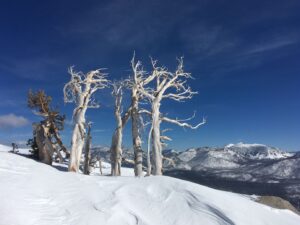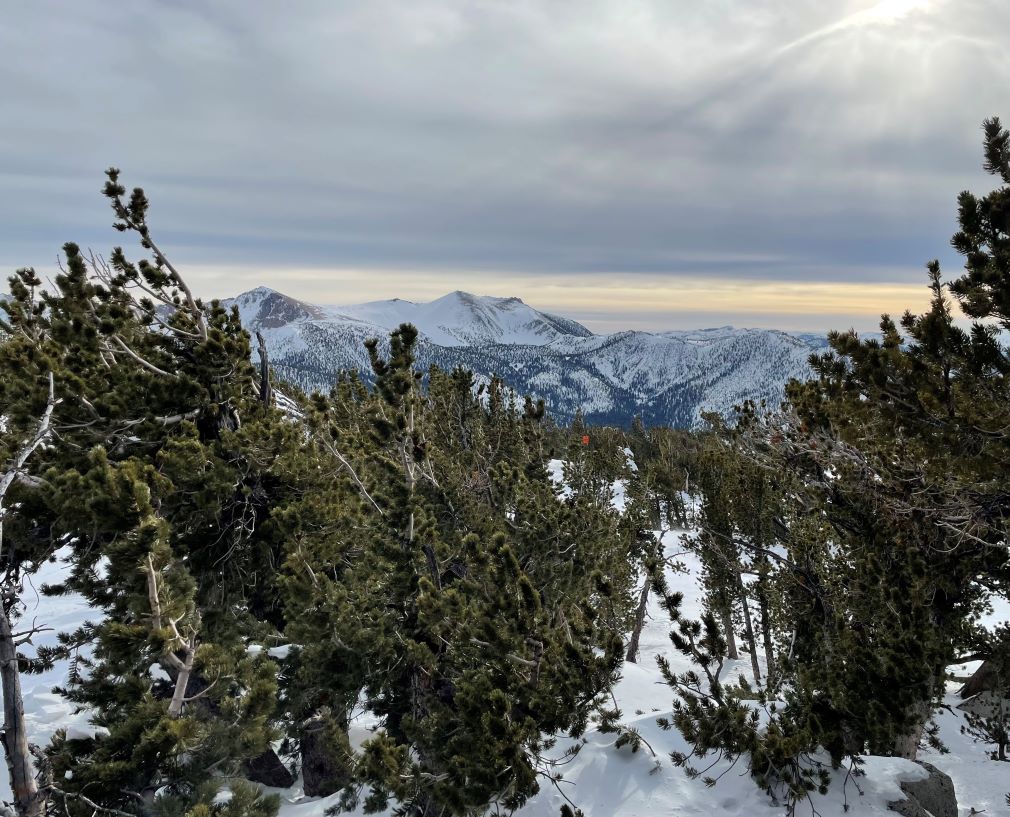Krummholz. German foresters coined this term in the early 20th century, and to an American ear, the word sounds as sturdy and enigmatic as the tree formations it describes. Translated to crooked wood, Krummholz describes the crouched appearance of a shrub to survive on windswept ridges at high elevations. Krummholz formations grow in stands along some of the Tahoe Rim Trail’s highest summits, with gnarled roots so intertwined that you can hardly tell one from the other. When you see these haunting trees in the Sierra—their shape etched by blizzards and hurricane-force winds—there’s a good chance that you’re looking at a Whitebark Pine.
You can double-check your identification skills by looking for clusters of five needles on ascending branches, sappy cones three to five inches long, and bark that looks flaky rather than fissured and is, well, white. If you happen to see a pale gray bird with black wings in the branches, you’re definitely on the right track. Not all Whitebark pines take on a Krummholz formation, but their relationship with a special bird species bird helps explain why so many do.
These unique birds assist this pine species in an essential way. Whitebark pines don’t drop their cones and they don’t open pinecone scales to release seeds either, as many trees do. They work in symbiosis with the aptly named Clarks Nutcracker, which dismantles cones in seconds and carries up to 90 seeds in their throat pouch at once, according to the Audubon Society. In late summer and fall, the birds bury their treasure on remote, windy western slopes that tend to accumulate less snow. They’ve been known to store up to 30,000 seeds in one season and have the uncanny ability to find them again in winter. When they don’t, a new stand of Whitebarks plants their roots in an inhospitable habitat they’ve evolved to endure.
Those tangled roots are part of what makes Pinus albicaulis special. Their twisted path into the subalpine soil prevents erosion in summer, stabilizes the snowpack in winter, and slows melting in spring. As warming snow filters through the trees’ roots, nutrients and sediment are captured on the slope and kept out of the tributaries leading to Lake Tahoe.
“They’re doing a huge amount to keep Tahoe blue,” said Tressa Gibbard, Program Manager at the Sugarpine Foundation, a non-profit based in South Lake Tahoe.
Gibbard’s work with the Foundation is to locate trees that show genetic resistance to white pine blister rust, a destructive, invasive and deadly tree fungus that plagues many pine species throughout Tahoe and beyond. Despite the havoc wreaked by invasive fungi, there are trees that have a natural genetic resistance to this fungus, which has been a shining light for conservation efforts. When pine trees with a fungus-resistant trait are identified, the Sugarpine Foundation collects their cones for analysis, harvest, reproduction, and replanting. Research shows that while there is genetic resistance to white pine blister rust among Pinus albicaulis, it isn’t simply one gene scientists can identify, as is the case with Sugarpines, but a combination of several genes that is harder to identify and replicate. The hope is that eventually, Whitebark pine genetic resistance will be identified in Tahoe, and can be replicated the same way that the Sugarpine Foundation does with other 5-needle pine species.
Healthy Whitebark pine populations have plummeted in recent years due to a deadly combination of drought and fire and the subsequent proliferation of pine beetles that attack these trees. In response, the United States Forest Service listed Pinus albicaulis as a threatened species under the Endangered Species Act in December 2022. For all the strength and resilience that these trees embody, the Whitebark pine is on a possible path to extinction.
After the official decision on the Whitebark’s threatened status, Williams and the LTBMU have received funding to begin a blister rust monitoring and screening project in Tahoe. But these trees could use your help, too.
The more Whitebark pines that we can identify with resistance to blister rust, the more seeds can be protected, harvested, replicated, and replanted.
With some hard work, we might just save this species for the next generation.
Snapping a picture of the next Whitebark you see while out on the trail could save hundreds, even thousands, of this important species. Photos don’t necessarily only need to be of healthy stands. The USFS is working hard to track down white pine blister rust, and it’s also important to know where the fungus has taken hold.
In fact, the California Native Plant Society, Pacific Crest Trail Association, and Whitebark Pine Ecosystem Foundation have created a citizen science project to collect photos of all 5-needle pines along the PCT using the software application iNaturalist. A quick search in the app for Whitebark pine identifications in the Tahoe area shows that citizen scientists in the Basin have identified the species on the stretch of the PCT that is co-aligned with the Tahoe Rim Trail and well beyond. The Tahoe Rim Trail Association urges our passionate trail users to join this effort.
In the iNaturalist app, you can simply take or upload a photo and tap a button that says, “What did you see?” for help with identification. Not only will the app help identify Whitebark pines, but it can also identify white pine blister rust, which is distinctly orange and bursts from the seams of sick trees. Whether snapping a photo at that moment or uploading one later on, iNaturalist will automatically include critical data about where and when the photo was taken whenever you make an identification. Practicing tree (and fungus) identification makes for an engaging time out on the trail, and when it comes to Whitebark, you never know the difference you could make.

Consider the picture on the right: a stand of dead Whitebark Pines, taken by Tressa Gibbard on Echo Peak.
But are they all dead? That little flash of green on the left side of the photo is the kind of observation that could make a difference. How did it survive whatever its neighbors did not? You don’t have to answer this question to pose it, and uploading your picture to a public database is a great place to start the search for a solution.
The plight of the Whitebark pine is a reminder that when we step onto the trail, we step into a story that is still being written. The question now is whether we can use our human influence to help write a happy ending for this striking, symbiotic, and resilient tree.
Check out the resources below for greater detail on Whitebark Pines:
American Forests resource page on the Whitebark Pine, including a link to “Hope and Restoration: Saving the Whitebark Pine,” an inspirational short documentary from the Cornell Lab of Ornithology: https://www.americanforests.org/save-the-whitebark-pine/
Michael Kauffmann’s website with a link to Pilot Fieldwork Reports including a 2014 report from the Tahoe Basin Management Unit: https://www.michaelkauffmann.net/california-whitebark-pine/
Overview from the U.S. Fish and Wildlife Service including information about the designation of the tree as a threatened species: https://www.fws.gov/species/whitebark-pine-pinus-albicaulis
Information about the Clark’s Nutcracker from the Audubon society: https://www.audubon.org/field-guide/bird/clarks-nutcracker
Information about White Pine Blister Rust from the Sugarpine Foundation: https://sugarpinefoundation.org/our-work/background/about-blister-rust


